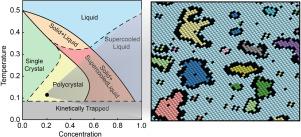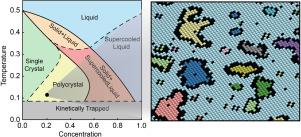纳米晶合金的完全热力学稳定模型
IF 9.3
1区 材料科学
Q1 MATERIALS SCIENCE, MULTIDISCIPLINARY
引用次数: 0
摘要
我们提出了一个多晶合金的模型,结合了晶粒取向的Potts模型和溶质热力学和扩散的晶格-气体模型。采用动力学蒙特卡罗模拟方法,在微态间建立非线性过渡垒,实现了该模型下合金的演化过程。该模型用于研究长期存在的问题,即适当溶质的晶界偏聚是否可以将晶界自由能驱动到零,从而产生具有有限晶粒尺寸的完全稳定的多晶态。该模型在一定条件下再现了稳定的多晶状态,假设溶质-溶质相互作用是排斥性的。使总自由能最小化的材料结构不是静态的。它处于晶粒生长和晶粒细化竞争过程的动态平衡状态。该合金通过在较大的基体晶粒中嵌入一组较小的晶粒来消除三重结。预测,如果实验实现完全稳定的纳米晶状态,其外观将与传统的(不稳定的)纳米晶材料大不相同。本文章由计算机程序翻译,如有差异,请以英文原文为准。


A model of full thermodynamic stabilization of nanocrystalline alloys
We propose a model of a polycrystalline alloy combining the Potts model for grain orientations with a lattice-gas model for solute thermodynamics and diffusion. The alloy evolution with this model is implemented by kinetic Monte Carlo simulations with nonlinear transition barriers between microstates. The model is applied to investigate the long-standing question of whether grain boundary (GB) segregation of an appropriate solute can drive the GB free energy to zero, creating a fully stabilized polycrystalline state with a finite grain size. The model reproduces stable polycrystalline states under certain conditions, provided the solute–solute interactions are repulsive. The material’s structure minimizing the total free energy is not static. It exists in a state of dynamic equilibrium between the competing processes of grain growth and grain refinement. The alloy eliminates triple junctions by forming a set of smaller grains embedded into a larger matrix grain. It is predicted that, if a fully stabilized nanocrystalline state is realized experimentally, it will look very different from the conventional (unstable) nanocrystalline materials.
求助全文
通过发布文献求助,成功后即可免费获取论文全文。
去求助
来源期刊

Acta Materialia
工程技术-材料科学:综合
CiteScore
16.10
自引率
8.50%
发文量
801
审稿时长
53 days
期刊介绍:
Acta Materialia serves as a platform for publishing full-length, original papers and commissioned overviews that contribute to a profound understanding of the correlation between the processing, structure, and properties of inorganic materials. The journal seeks papers with high impact potential or those that significantly propel the field forward. The scope includes the atomic and molecular arrangements, chemical and electronic structures, and microstructure of materials, focusing on their mechanical or functional behavior across all length scales, including nanostructures.
 求助内容:
求助内容: 应助结果提醒方式:
应助结果提醒方式:


